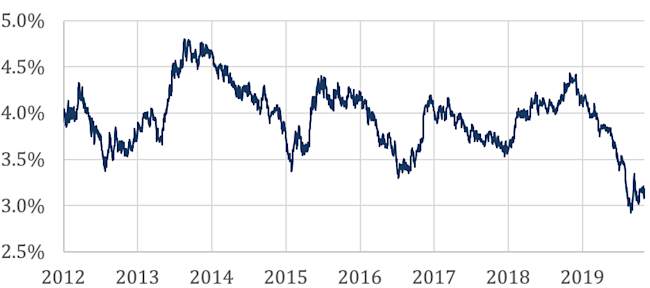Interest rates 2019 — signal or noise?
Interest rates 2019 -- signal or noise?
Medium- and long-term interest rates have declined 75-100 basis points since the beginning of the year. We have published a series of articles on measuring UVBs for variable-rate premiums, managing funding and PBGC variable-rate premiums in a volatile interest rate environment, DB funding strategy, and the effect of interest rate declines on DC plans.
In this article we very briefly discuss long-run trends in interest rates, as a framework for evaluating current interest rate volatility.
Rates since 1982
Chart 1 maps yields on long-term corporate bonds since 1982.

Chart 1 – Moody’s Aa long-term corporate bond yields1982 – present
The pattern appears to be periods (lasting as long as eight years – e.g., from 1994-2002) of relative stability, followed by an adjustment down, followed by another period of stability. We have “boxed-out” the periods of stability in the chart.
The trend has (for the most part) been in only one direction: down.
2012 – present
Chart 2 maps the same yields over the most recent period of stability – from 2012 to date.

Chart 2 – Moody’s Aa long-term corporate bond yields2012 – present
During this period, yields have moved between highs of around 4.5% and lows of around 3.5%.
Since mid-July, these yields have been below 3.5% (3.22% as of November 13, 2019).
The open question
The question, particularly for DB plan sponsors for whom plan-related interest rate risk is a significant factor, is whether the lower rates we have experienced in the second half of 2019 represent a “new normal” – another downward step on the downward stairstep graphed in Chart 1 – or just a lower version of the current bottom, reflecting the issues typically talked about in current news (monetary policy and trade “uncertainty”).
The next months may answer this question.
These low rates are likely to affect 2020 valuations
As we approach year-end, and as rates continue to remain near all-time lows, it becomes increasingly likely that 2020 valuation interest rates will be at significantly lower rates than 2019 – likely 100 or more basis points lower.
For a typical pension plan, that decline will increase liabilities by close to 20% compared to the end of 2019. That increase may, for funding purposes, be partly or wholly offset by asset gains for many plans (stocks have also gained 20% so far this year).
This decline in rates will make 2020 derisking transactions more expensive. For some plans at least, it will increase Pension Benefit Guaranty Corporation variable-rate premiums. It is not likely, however, to show up in ERISA minimum funding requirements until 2021 and later (under current rules at least) – when Highway and Transportation Funding Act (HATFA) funding relief is reduced.
Our prior articles (linked at the beginning of this article) discuss these issues in detail.
* * *
We will continue to follow this issue.
